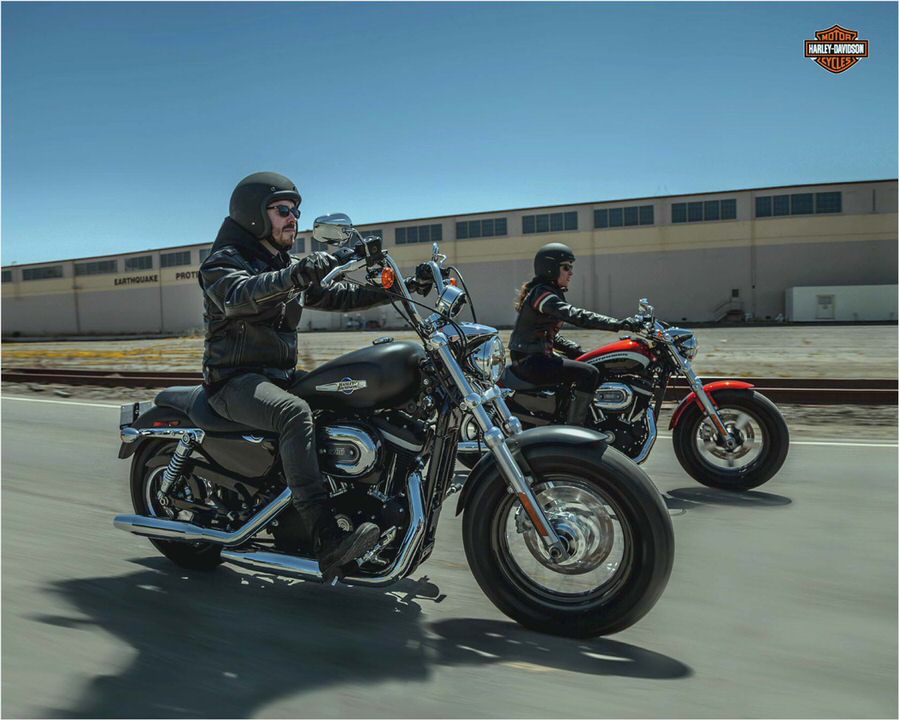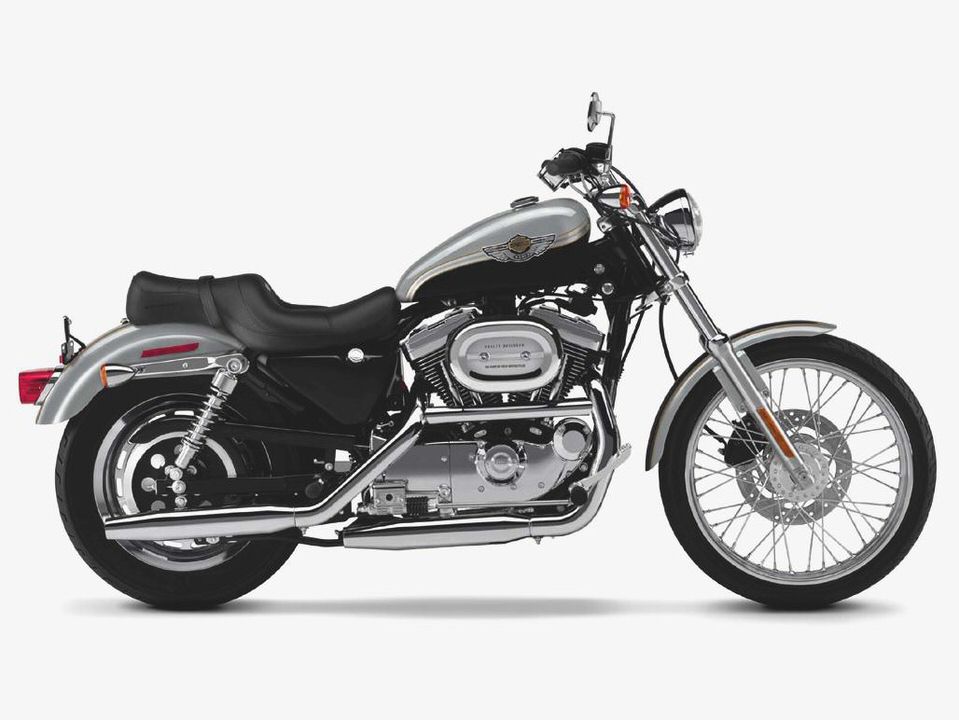
0406_13z+2004_Harley_Davidson_XL1200C_Sportster+Left_Side_View_Riding.jpg
With all the hoopla surrounding Harley-Davidson’s 100th anniversary last year, it did not come as a complete surprise that the Motor Company had little to offer riders by way of earth-shattering technology or new motorcycles. This left us wondering what it had up its sleeves to kick off the first year of its second century in business.
We got our answer when we reported back in the January ’04 issue of HOT ROD BIKES — the major change to the ’04 model line was aimed straight at the Sportster family. Wondering why such a monumental change was made to a family of bikes which only makes up about 20 percent of all Harleys sold, prompted us to look a little deeper and find out why.
Since the Sportster was introduced back in 1957, just under 787,000 of the stripped-down machines have been produced in varying styles. The bike has undergone design changes on the average of every four to five years, although nothing compared to this year’s major redesign. Of the 57,000 or so Sportsters sold last year, 75 percent of them were sold to buyers who were purchasing their first Harley-Davidson.
When surveyed by the Motor Company, 95 percent of Sportster owners reported they planed on buying another Harley in the future. Considering most of us would come to the conclusion that the next bike a Sportster owner would purchase would be some type of Big Twin, it would only make sense for Harley to design and build a better Sportster to bring more people to the brand and keep them there.
This is not to say that the ’03-and-earlier models were bad bikes, quite the contrary, but they do have some drawbacks. The main one being vibrations transmitting from the solid-mounted engine, through the frame and controls, eventually finding their way to the rider.
Back in the fall of 2003, we had the chance to try out the new Sportsters as we, along with some other motorcycle journalists, put a total of about 200 miles on a variety of models, including the 883, the 883C, the 1200R, and the 1220C.
For testing purposes, we checked out a 1200 Custom, riding it as our everyday motorcycle. The bike performed commuting duty on the heavily congested Southern California freeway system, made multiple trips to local establishments, as well as a few leisurely rides on the coast, mixed in with adrenaline-pumping rides through the local canyons.
The first thing you notice with the new bike is that although it has been totally redesigned, it still maintains its heritage as a narrow, nimble machine ready to carry its hot-rod tradition well into the future.
By far, the two main changes to the bike this year are the new motor and the completely redesigned frame built to carry the Buell-born 1200 (73.4ci) 45-degree V-twin. In an effort to make the bike more comfortable to allow for easy all-day cruising, a decision was made to come up with a more powerful motor that would be able to provide smoother delivery of available horsepower and torque to the rear wheel.
H-D’s engineering staff needed to look no further than last year’s new Buell XB motor platform. With a few exceptions, the motors are identical.
In a major departure from previous Sportster models, the ’04 engine and transmission are rubber-mounted to the frame. With technology and experience gained over the years, designers came up with a system which uses rubber isolators with differing degrees of stiffness to come up with just the right combination to provide for both comfort and handling. In addition to the isolators are a series of three dog bone-shaped stabilizer links (complete with rubber isolators) designed to allow the powerplant to move in a radial motion, while keeping sideways flexing of the frame to a minimum.
Knowing that the smoother motor would translate into riders pushing the bike both longer and harder, numerous improvements have been incorporated into the motor to help it keep up with those demands. Advances such as piston oiling jets, increased oil capacity, and larger cooling fins surrounding the cylinders all help in keeping the operating temperatures within limits.
Other engine modifications include lighter pistons, connecting rods, and piston pins, a new crankshaft speed sensor which manages engine timing, new high-flow ported heads, redesigned camshafts, new two-piece rocker box covers, and a one-piece tappet cover. All of these changes result in a powerful motor with a 9.7:1 compression ratio capable of producing 79 lb-ft of torque at 3,500 rpm, and 70 hp at the 6,000 rpm redline, when measured at the crank.

Visually, the 1200C’s motor looks stunning with its black powdercoated cases, cylinders, and heads, which contrast nicely with the polished fins, chrome cam, and primary covers, as well as the chrome rocker boxes. Viewing the motor from the pipe side reveals a welcome change: the old crossover pipe, which used to hide a good portion of the cylinders, has been replaced by a new crossover similar to the one used on a Dyna, hidden behind the mufflers. Taking advantage of the new cleaned-up side of the engine is a redesigned chrome air cleaner complete with a Sportster 1200 logo.
The bike’s overall 90.3-inch length and 60.4-inch wheelbase is supported by a 21-inch laced front wheel and a 16-inch chromed slotted disc wheel fit with a beefy looking Dunlop D401 150/80B1671H. The new Nissin four-piston brake calipers do a very good job bringing the 554-pound (dry) machine to a sure and predictable stop with very little lever effort.
Making the bike more attractive to riders of smaller stature is a seat height of 26.3 inches (with a 180-pound rider), and a redesigned oil tank fit with a flush-mount cap/dipstick, making for a narrower width below the seat and translating into a more comfortable seating position. Smaller diameter 1-1/8-inch grips make reaching the clutch lever, which requires less effort than before, much easier. The bars are finished off with a single handlebar-mounted electronic speedo and indicator lights.
A new electronics package is incorporated into the Sportster, allowing for a better diagnostics package in addition to an optional factory security system.
The cosmetic package on our 1200C includes a Luxury Teal/Brilliant Silver two-tone paintjob that conceals the redesigned 4.5-gallon fuel tank, a departure from the traditional peanut tank. The tank is trimmed out with a top-mounted chrome strip which incorporates the filler and beautiful teal script-style Harley-Davidson markings on both sides of the tank.
No matter where we rode the bike, it performed even better than advertised. The motor delivered far more power and torque than we were used to from any of the earlier Sportsters (although the particular one we had was very cold blooded, once it got up to operating temp we had no complaints). The new stiffer frame design (26 percent) coupled with the rubber-mounted engine provided a very different experience than we had ever had on a Sportster.
We could actually feel the interaction between the tires and the asphalt, whereas in the past, engine vibrations masked this.
The 1200 Custom comes with an MSRP of $9,845, certainly not cheap, but still very affordable. Considering how well the bike performs, we feel it is a very good value. Add to that the beautiful styling, and we are convinced that Harley has come up with a big winner.
- Last chance before eBay 1988 harley sportster muscle
- Harley-Davidson 2009 Sportster 1200 Low Harley-Davidson
- POLICE HARLEYS, 100 YEARS OF POLICE ON HARLEYS
- How to Customize a Harley-Davidson V-Rod eHow
- Harley Davidson XR 1200 prototype

